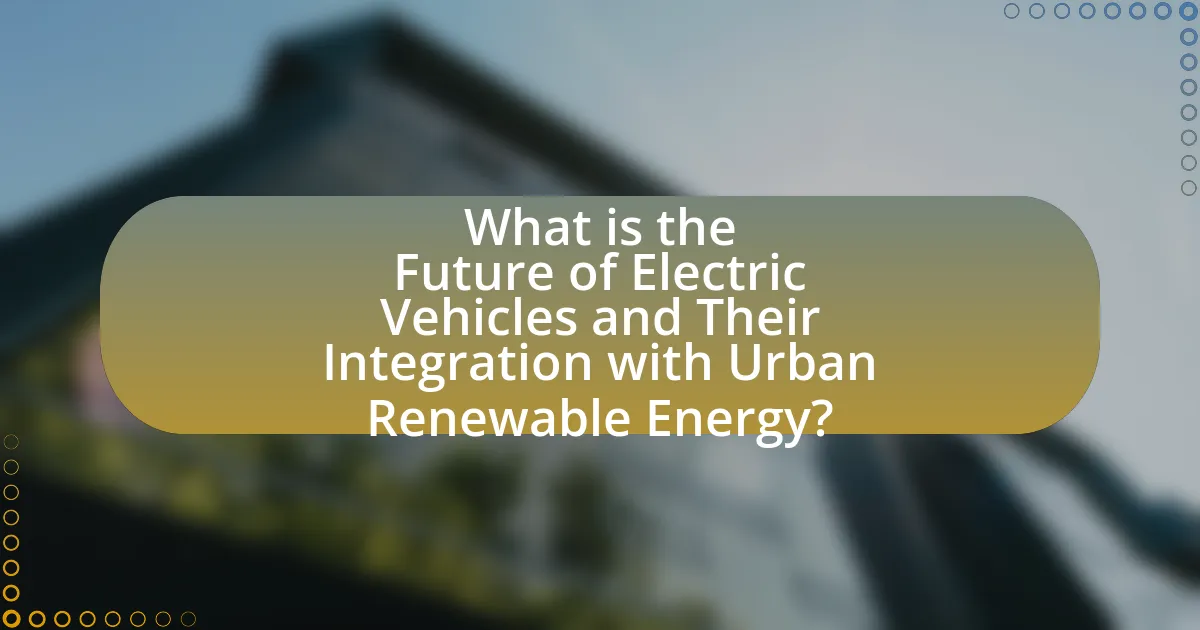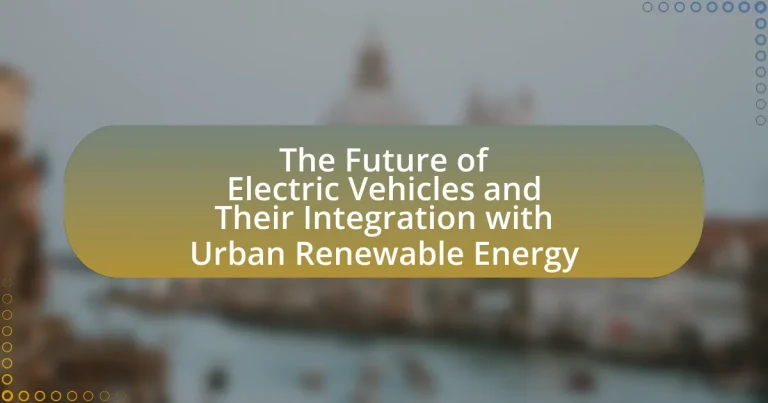The article focuses on the future of electric vehicles (EVs) and their integration with urban renewable energy systems, emphasizing the potential for enhanced sustainability and reduced greenhouse gas emissions. It explores how advancements in technology, infrastructure, and urban planning are facilitating the evolution of EVs in cities, alongside the importance of renewable energy sources like solar and wind in powering these vehicles. Key topics include the role of smart grids, the impact of government policies, the challenges faced in infrastructure development, and the economic benefits of this integration. The article also highlights future trends, consumer behavior, and practical steps cities can take to promote the adoption of electric vehicles and renewable energy solutions.

What is the Future of Electric Vehicles and Their Integration with Urban Renewable Energy?
The future of electric vehicles (EVs) is closely tied to their integration with urban renewable energy systems, which is expected to enhance sustainability and reduce greenhouse gas emissions. As cities increasingly adopt renewable energy sources like solar and wind, EVs will serve as mobile energy storage units, allowing for the efficient use of excess energy generated during peak production times. For instance, studies indicate that integrating EVs with smart grids can optimize energy distribution and reduce reliance on fossil fuels, with projections showing that by 2030, EVs could account for over 30% of global vehicle sales, significantly impacting urban energy consumption patterns. This synergy not only supports the transition to cleaner transportation but also promotes energy resilience in urban environments.
How are electric vehicles evolving in urban environments?
Electric vehicles (EVs) are evolving in urban environments through advancements in technology, infrastructure development, and integration with renewable energy sources. Urban areas are increasingly adopting smart charging stations that utilize renewable energy, such as solar and wind, to power EVs, thereby reducing carbon emissions and enhancing sustainability. For instance, cities like San Diego have implemented solar-powered charging stations, which not only charge EVs but also feed excess energy back into the grid. Additionally, urban planning is incorporating dedicated EV lanes and parking spaces, facilitating easier access and encouraging adoption. According to a report by the International Energy Agency, the number of electric cars on the road reached 10 million globally in 2020, with urban areas leading in adoption due to supportive policies and incentives. This evolution reflects a broader trend towards sustainable urban mobility solutions.
What technological advancements are driving electric vehicle development?
Technological advancements driving electric vehicle development include improvements in battery technology, electric drivetrains, and charging infrastructure. Enhanced lithium-ion batteries, for instance, have significantly increased energy density and reduced costs, with prices dropping by over 80% since 2010, making electric vehicles more affordable and accessible. Additionally, advancements in solid-state batteries promise even greater efficiency and safety, potentially doubling the range of electric vehicles. Electric drivetrains have also become more efficient, with innovations in power electronics and motor design leading to better performance and lower energy consumption. Furthermore, the expansion of fast-charging networks, supported by technologies like ultra-fast charging and wireless charging, facilitates quicker recharging times, addressing range anxiety and promoting wider adoption of electric vehicles.
How do urban infrastructures support electric vehicle integration?
Urban infrastructures support electric vehicle integration by providing essential charging stations, dedicated lanes, and smart grid technology. Charging stations are strategically placed throughout cities, enabling convenient access for electric vehicle users, which encourages adoption. For instance, cities like San Francisco have implemented extensive networks of public charging points, with over 1,000 charging stations available, facilitating the transition to electric mobility. Additionally, dedicated lanes for electric vehicles can enhance traffic flow and reduce congestion, making electric vehicles a more attractive option. Smart grid technology further supports integration by optimizing energy distribution and managing charging loads, ensuring that renewable energy sources, such as solar and wind, are effectively utilized. This infrastructure not only promotes the use of electric vehicles but also aligns with urban sustainability goals, as seen in cities aiming for carbon neutrality by 2030.
Why is the integration of renewable energy important for electric vehicles?
The integration of renewable energy is crucial for electric vehicles because it enhances sustainability and reduces greenhouse gas emissions. Electric vehicles powered by renewable energy sources, such as solar or wind, contribute to a significant decrease in carbon footprints compared to those charged with fossil fuel-generated electricity. According to the International Energy Agency, transitioning to renewable energy for electric vehicle charging can reduce emissions by up to 70% in certain regions. This shift not only supports global climate goals but also promotes energy independence and resilience in urban environments.
What types of renewable energy sources are most compatible with electric vehicles?
Solar energy and wind energy are the most compatible renewable energy sources with electric vehicles. Solar energy can be harnessed through photovoltaic panels installed on homes or charging stations, providing a direct source of electricity for EV charging. Wind energy, generated by turbines, can also supply electricity to the grid, which can then be used to charge electric vehicles. According to the U.S. Department of Energy, integrating solar and wind energy into the electric grid can significantly reduce greenhouse gas emissions and reliance on fossil fuels, making them ideal for supporting the growing demand for electric vehicle charging infrastructure.
How does renewable energy impact the sustainability of electric vehicles?
Renewable energy significantly enhances the sustainability of electric vehicles by reducing their overall carbon footprint. When electric vehicles are charged using renewable energy sources such as solar, wind, or hydroelectric power, the emissions associated with electricity generation are minimized. For instance, a study by the International Energy Agency (IEA) indicates that electric vehicles charged with renewable energy can reduce greenhouse gas emissions by up to 70% compared to those charged with fossil fuels. This transition not only lowers the environmental impact of electric vehicles but also promotes a cleaner energy ecosystem, aligning with global sustainability goals.
What challenges do electric vehicles face in urban renewable energy integration?
Electric vehicles face several challenges in urban renewable energy integration, primarily including infrastructure limitations, grid capacity issues, and regulatory hurdles. Infrastructure limitations arise from the insufficient number of charging stations powered by renewable sources, which restricts the widespread adoption of electric vehicles. Grid capacity issues occur as the demand for electricity from both electric vehicles and renewable energy sources can exceed the existing grid’s capabilities, leading to potential overloads. Regulatory hurdles involve the need for policies that support the integration of electric vehicles with renewable energy systems, which are often lacking or inconsistent across different urban areas. These challenges hinder the effective synergy between electric vehicles and urban renewable energy initiatives, impacting overall sustainability goals.
What are the barriers to widespread adoption of electric vehicles in cities?
The barriers to widespread adoption of electric vehicles in cities include high upfront costs, inadequate charging infrastructure, limited driving range, and consumer skepticism. High upfront costs deter potential buyers, as electric vehicles often have a higher purchase price compared to traditional vehicles. Inadequate charging infrastructure creates challenges for users, as the lack of accessible charging stations can lead to range anxiety. Limited driving range further complicates adoption, as many consumers are concerned about the ability to travel long distances without recharging. Consumer skepticism regarding the reliability and performance of electric vehicles also hinders acceptance, as potential buyers may doubt the technology’s maturity. These factors collectively impede the transition to electric vehicles in urban environments.
How can urban planning address these challenges?
Urban planning can address the challenges of integrating electric vehicles with urban renewable energy by implementing infrastructure that supports charging stations and renewable energy sources. For instance, cities can designate specific areas for electric vehicle charging infrastructure, ensuring accessibility and convenience for users. Additionally, urban planners can promote the use of solar panels on buildings and parking structures, which can provide renewable energy for charging stations. Research indicates that cities with well-planned electric vehicle infrastructure see a higher adoption rate of electric vehicles, as evidenced by a study from the International Council on Clean Transportation, which found that cities with extensive charging networks experienced a 50% increase in electric vehicle usage.
How can electric vehicles and renewable energy work together effectively?
Electric vehicles (EVs) and renewable energy can work together effectively by utilizing smart charging systems that align EV charging with periods of high renewable energy generation. This integration allows EVs to charge when solar or wind energy is abundant, reducing reliance on fossil fuels and lowering greenhouse gas emissions. For instance, studies show that charging EVs during peak solar production can decrease carbon emissions by up to 80% compared to charging from traditional energy sources. Additionally, vehicle-to-grid (V2G) technology enables EVs to return stored energy back to the grid, providing stability and supporting renewable energy integration. This symbiotic relationship enhances energy efficiency and promotes a sustainable urban energy ecosystem.
What role do government policies play in promoting electric vehicles and renewable energy integration?
Government policies play a crucial role in promoting electric vehicles (EVs) and renewable energy integration by providing incentives, regulations, and infrastructure development. These policies include tax credits for EV purchases, grants for renewable energy projects, and mandates for renewable energy usage, which collectively encourage consumer adoption and investment in clean technologies. For instance, the U.S. federal government offers a tax credit of up to $7,500 for electric vehicle buyers, significantly lowering the cost barrier and stimulating market demand. Additionally, policies that require utilities to source a certain percentage of their energy from renewable sources, such as the Renewable Portfolio Standards in various states, facilitate the integration of renewable energy into the grid, supporting the infrastructure needed for EV charging. These combined efforts demonstrate how government intervention can effectively drive the transition towards sustainable transportation and energy systems.

What are the benefits of integrating electric vehicles with urban renewable energy?
Integrating electric vehicles with urban renewable energy enhances energy efficiency and reduces greenhouse gas emissions. This integration allows electric vehicles to utilize clean energy sources, such as solar and wind, for charging, which decreases reliance on fossil fuels. For instance, a study by the International Energy Agency indicates that electric vehicles charged with renewable energy can reduce carbon emissions by up to 70% compared to traditional gasoline vehicles. Additionally, this synergy can lead to improved grid stability, as electric vehicles can act as energy storage systems, providing power back to the grid during peak demand times. This dual functionality not only optimizes energy use but also supports the transition to sustainable urban environments.
How does this integration contribute to reducing carbon emissions?
The integration of electric vehicles (EVs) with urban renewable energy systems significantly reduces carbon emissions by enabling the use of clean energy for vehicle charging. When EVs are charged using renewable sources such as solar or wind power, the reliance on fossil fuels diminishes, leading to lower greenhouse gas emissions. For instance, a study by the International Energy Agency (IEA) indicates that transitioning to EVs powered by renewables can reduce CO2 emissions from the transportation sector by up to 70% by 2030. This integration not only promotes cleaner air but also enhances the efficiency of energy use in urban environments, further contributing to sustainability goals.
What are the long-term environmental impacts of electric vehicles powered by renewable energy?
Electric vehicles powered by renewable energy significantly reduce greenhouse gas emissions over their lifecycle compared to traditional fossil fuel vehicles. Studies indicate that electric vehicles (EVs) can lower carbon dioxide emissions by up to 70% when charged with renewable sources like wind or solar energy, as opposed to coal or natural gas. Additionally, the use of renewable energy for EVs minimizes air pollutants, contributing to improved urban air quality and public health. Research from the International Council on Clean Transportation shows that transitioning to EVs powered by renewables can lead to a substantial decrease in particulate matter and nitrogen oxides, which are harmful to human health. Furthermore, the long-term reliance on renewable energy for EVs promotes sustainable energy practices, reducing dependence on finite fossil fuel resources and fostering a circular economy through battery recycling initiatives.
How does this integration enhance energy efficiency in urban areas?
The integration of electric vehicles (EVs) with urban renewable energy systems enhances energy efficiency by enabling smart grid technologies that optimize energy distribution and consumption. This synergy allows for the storage of excess renewable energy generated during peak production times, such as solar energy during the day, which can then be utilized to charge EVs, reducing reliance on fossil fuels. According to a study by the International Energy Agency, integrating EVs with renewable energy sources can lead to a 30% reduction in greenhouse gas emissions in urban settings, demonstrating the significant impact of this integration on energy efficiency.
What economic advantages arise from the integration of electric vehicles and renewable energy?
The integration of electric vehicles and renewable energy leads to significant economic advantages, including reduced operational costs and enhanced energy efficiency. Electric vehicles (EVs) typically have lower fuel and maintenance costs compared to traditional internal combustion engine vehicles, with studies indicating that EVs can save owners up to $1,000 annually on fuel and maintenance. Additionally, renewable energy sources, such as solar and wind, provide a sustainable and often cheaper alternative to fossil fuels, further decreasing the overall cost of energy for EV charging.
Moreover, the combination of EVs and renewable energy can stimulate job creation in sectors such as manufacturing, installation, and maintenance of renewable energy systems and EV infrastructure. According to the International Renewable Energy Agency, the renewable energy sector employed over 11 million people globally in 2018, a number that continues to grow as the demand for clean energy solutions increases.
Furthermore, integrating EVs with renewable energy can lead to grid stability and resilience, reducing the economic impact of energy price volatility and enhancing energy security. This integration allows for better demand response strategies, which can optimize energy use and reduce costs during peak demand periods. Overall, the economic advantages of integrating electric vehicles with renewable energy are substantial, promoting cost savings, job creation, and energy security.
How can cities benefit financially from adopting electric vehicle infrastructure?
Cities can benefit financially from adopting electric vehicle infrastructure through increased revenue from charging stations, reduced operational costs, and enhanced economic development. By installing public charging stations, cities can generate income from usage fees, which can contribute to local budgets. Additionally, electric vehicles typically have lower maintenance and fuel costs compared to traditional vehicles, leading to savings in municipal fleet operations. Furthermore, the presence of electric vehicle infrastructure can attract businesses and residents interested in sustainable practices, stimulating local economies. A study by the International Council on Clean Transportation found that cities investing in electric vehicle infrastructure can see a return on investment through job creation and increased tax revenues from new businesses.
What job opportunities are created through this integration?
The integration of electric vehicles with urban renewable energy creates job opportunities in several sectors, including renewable energy installation, electric vehicle maintenance, and smart grid technology development. Specifically, the demand for solar panel and wind turbine technicians increases as cities adopt renewable energy sources to power electric vehicle charging stations. Additionally, there is a growing need for skilled workers in electric vehicle servicing and repair, as the number of electric vehicles on the road rises. Furthermore, jobs in software development and data analysis emerge to support the smart grid systems that manage energy distribution and optimize charging schedules for electric vehicles. This trend is supported by the U.S. Bureau of Labor Statistics, which projects that employment in renewable energy sectors will grow significantly, reflecting the increasing investment in sustainable technologies.

What are the future trends in electric vehicles and urban renewable energy integration?
Future trends in electric vehicles (EVs) and urban renewable energy integration include increased adoption of vehicle-to-grid (V2G) technology, enhanced charging infrastructure, and the rise of smart cities. V2G technology allows EVs to not only draw power from the grid but also return energy during peak demand, thus stabilizing the grid and optimizing renewable energy use. According to a study by the International Energy Agency, the number of EVs on the road is projected to reach 145 million by 2030, significantly increasing the potential for V2G applications.
Additionally, urban areas are investing in extensive charging networks powered by renewable sources, such as solar and wind, to support the growing EV market. The Global EV Outlook 2023 highlights that cities are increasingly integrating renewable energy into their transportation systems, promoting sustainability and reducing carbon emissions. Smart city initiatives are also leveraging data analytics and IoT technologies to optimize energy consumption and improve the efficiency of EV charging stations, further enhancing the synergy between electric vehicles and urban renewable energy systems.
How will advancements in battery technology influence electric vehicle adoption?
Advancements in battery technology will significantly enhance electric vehicle (EV) adoption by improving energy density, reducing costs, and increasing charging speed. Higher energy density allows EVs to travel longer distances on a single charge, addressing range anxiety, which is a major barrier to adoption. For instance, solid-state batteries, which are being developed, can potentially offer energy densities exceeding 300 Wh/kg, compared to current lithium-ion batteries that average around 150-250 Wh/kg.
Additionally, cost reductions in battery production, projected to fall below $100 per kilowatt-hour by 2025, will make EVs more affordable for consumers, thereby increasing market penetration. The International Energy Agency reported that lower battery costs have already contributed to a 50% decrease in EV prices over the past decade.
Faster charging technologies, such as ultra-fast charging systems that can recharge batteries to 80% in under 30 minutes, will further enhance the convenience of EVs, making them more appealing to potential buyers. As these advancements continue to evolve, they will collectively drive higher adoption rates of electric vehicles, facilitating a transition towards sustainable urban transportation integrated with renewable energy sources.
What innovations are expected in charging infrastructure?
Innovations in charging infrastructure are expected to include ultra-fast charging stations, wireless charging technology, and smart grid integration. Ultra-fast charging stations can significantly reduce charging times, with some capable of delivering up to 350 kW, allowing electric vehicles to charge to 80% in under 15 minutes. Wireless charging technology, utilizing inductive charging pads, offers convenience by eliminating the need for physical connections, enhancing user experience. Smart grid integration enables real-time energy management, optimizing charging based on renewable energy availability and grid demand, which is crucial for sustainable urban energy systems. These advancements are supported by ongoing investments and research in electric vehicle technology, indicating a strong trend towards more efficient and user-friendly charging solutions.
How will smart grid technology enhance the integration process?
Smart grid technology will enhance the integration process by enabling real-time communication and data exchange between energy producers, consumers, and storage systems. This capability allows for better management of energy flows, optimizing the use of renewable energy sources such as solar and wind. For instance, smart grids can facilitate demand response programs, where energy consumption is adjusted based on supply availability, thus improving grid reliability and efficiency. Additionally, studies indicate that smart grid implementations can lead to a 10-30% reduction in energy costs and a significant increase in the integration of distributed energy resources, which is crucial for supporting the growing adoption of electric vehicles in urban settings.
What role will consumer behavior play in the future of electric vehicles?
Consumer behavior will significantly influence the future of electric vehicles (EVs) by driving demand, shaping market trends, and impacting manufacturers’ strategies. As consumers increasingly prioritize sustainability and environmental concerns, the adoption of EVs is expected to rise; for instance, a 2021 survey by McKinsey found that 70% of consumers are willing to pay more for sustainable products. Additionally, consumer preferences for technology features, such as advanced driver-assistance systems and connectivity, will push manufacturers to innovate and enhance their offerings. This shift in consumer behavior will not only accelerate the transition to electric mobility but also encourage the integration of EVs with urban renewable energy systems, as consumers seek efficient and eco-friendly transportation solutions.
How can public awareness campaigns influence electric vehicle adoption?
Public awareness campaigns can significantly influence electric vehicle adoption by educating consumers about the benefits and availability of electric vehicles. These campaigns often highlight environmental advantages, such as reduced greenhouse gas emissions, and economic benefits, including lower operating costs compared to traditional vehicles. For instance, a study by the International Council on Clean Transportation found that increased public awareness led to a 20% rise in electric vehicle sales in regions where campaigns were implemented. By effectively communicating these advantages, public awareness campaigns can shift consumer perceptions and encourage more individuals to consider electric vehicles as a viable option.
What factors affect consumer choices regarding electric vehicles?
Consumer choices regarding electric vehicles are primarily influenced by factors such as price, range, charging infrastructure, environmental concerns, and government incentives. Price plays a crucial role, as consumers often compare the upfront costs of electric vehicles to traditional gasoline vehicles; for instance, the average price of electric vehicles in the U.S. was around $56,000 in 2022, which can deter potential buyers. Range anxiety, or the fear of running out of battery power, also affects decisions, with many consumers preferring vehicles that can travel at least 250 miles on a single charge.
The availability of charging infrastructure significantly impacts consumer confidence; a study by the International Council on Clean Transportation found that regions with more charging stations see higher electric vehicle adoption rates. Environmental concerns drive many consumers to choose electric vehicles, as they seek to reduce their carbon footprint; a survey by the Pew Research Center indicated that 39% of Americans consider environmental impact a major factor in their vehicle choice. Lastly, government incentives, such as tax credits and rebates, can lower the effective cost of electric vehicles, making them more attractive; for example, the federal tax credit in the U.S. can provide up to $7,500 off the purchase price, influencing consumer decisions.
What practical steps can cities take to promote electric vehicle and renewable energy integration?
Cities can promote electric vehicle and renewable energy integration by implementing comprehensive charging infrastructure and incentivizing renewable energy sources. Establishing widespread, accessible charging stations powered by solar or wind energy encourages electric vehicle adoption. For instance, cities like San Diego have installed solar-powered charging stations, which not only support electric vehicles but also reduce reliance on fossil fuels. Additionally, offering tax incentives or rebates for electric vehicle purchases and renewable energy installations can further stimulate growth in both sectors. Research indicates that cities with supportive policies see a higher rate of electric vehicle adoption, demonstrating the effectiveness of these practical steps.


